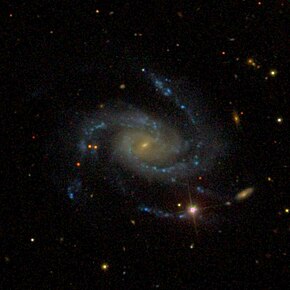
NGC 6946, sometimes referred to as the Fireworks Galaxy, is a face-on intermediate spiral galaxy with a small bright nucleus, whose location in the sky straddles the boundary between the northern constellations of Cepheus and Cygnus. Its distance from Earth is about 25.2 million light-years or 7.72 megaparsecs, similar to the distance of M101 in the constellation Ursa Major. Both were once considered to be part of the Local Group, but are now known to be among the dozen bright spiral galaxies near the Milky Way but beyond the confines of the Local Group. NGC 6946 lies within the Virgo Supercluster.

NGC 2207 and IC 2163 are a pair of colliding spiral galaxies about 80 million light-years away in the constellation Canis Major. NGC 2207 was discovered by British astronomer John Herschel on 24 January 1835, while IC 2163 was discovered by Herbert Howe on 11 February 1898.

NGC 1309 is a spiral galaxy located approximately 120 million light-years away, appearing in the constellation Eridanus. It was discovered by German-British astronomer William Herschel on 3 October 1785.

NGC 4567 and NGC 4568 are a set of unbarred spiral galaxies about 60 million light-years away in the constellation Virgo. They were both discovered by William Herschel in 1784. They are part of the Virgo Cluster of galaxies.
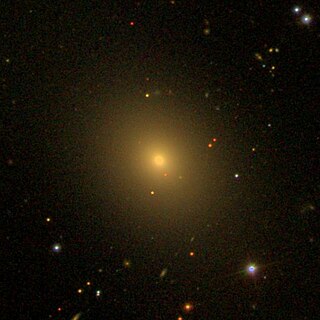
NGC 57 is an elliptical galaxy in the constellation Pisces. It was discovered by German-British astronomer William Herschel on 8 October 1784.
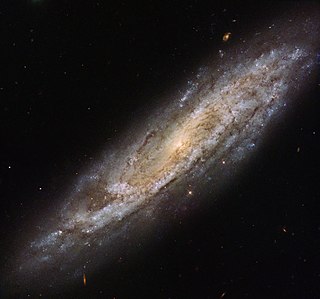
NGC 2770 is a spiral galaxy in the northern constellation of Lynx, near the northern constellation border with Cancer. It was discovered by German-born astronomer William Herschel on December 7, 1785. J. L. E. Dreyer described it as, "faint, large, much extended 150°, mottled but not resolved, 2 stars to north". NGC 2770 was the target for the first binocular image produced by the Large Binocular Telescope.

NGC 935 and IC 1801 are a pair of interacting galaxies within the Aries constellation. They were discovered on 18 September 1885 by Lewis Swift. NGC 935 is the northern member of the pair, and IC 1801 is the southern. Together, they are listed in Halton Arp's Atlas of Peculiar Galaxies as Arp 276, as an example of interacting galaxies.

Arp 271 is a pair of similarly sized interacting spiral galaxies, NGC 5426 and NGC 5427, in the constellation of Virgo. It is not certain whether the galaxies are going to eventually collide or not. They will continue interacting for tens of millions of years, creating new stars as a result of the mutual gravitational attraction between the galaxies, a pull seen in the bridge of stars already connecting the two. Located about 130 million light-years away, the Arp 271 pair is about 130,000 light-years across. It was originally discovered in 1785 by William Herschel. It is speculated, that the Milky Way will undergo a similar collision in about five billion years with the neighbouring Andromeda Galaxy, which is currently located about 2.6 million light-years away.

NGC 3938 is an unbarred spiral galaxy in the Ursa Major constellation. It was discovered on 6 February 1788 by William Herschel. It is one of the brightest spiral galaxies in the Ursa Major South galaxy group and is roughly 67,000 light years in diameter. It is approximately 43 million light years away from Earth. NGC 3938 is classified as type Sc under the Hubble sequence, a loosely wound spiral galaxy with a smaller and dimmer bulge. The spiral arms of the galaxy contain many areas of ionized atomic hydrogen gas, more so towards the center.

NGC 1187 is a barred spiral galaxy located about 60 million light-years away in the constellation of Eridanus. It was discovered on December 9, 1784 by the astronomer William Herschel.
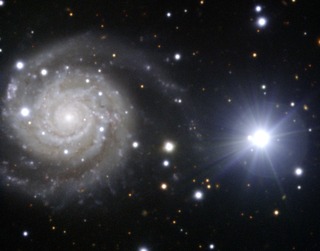
NGC 3244 is a spiral galaxy in the constellation Antlia. Its velocity with respect to the cosmic microwave background is 3068 ± 22 km/s, which corresponds to a Hubble distance of 147.6 ± 10.4 Mly (45.25 ± 3.18 Mpc). However, 10 non-redshift measurements give a closer distance of 91.88 ± 7.36 Mly (28.170 ± 2.256 Mpc). It was discovered by British astronomer John Herschel on 22 April 1835.

NGC 6181 is a barred spiral galaxy located in the constellation Hercules. It is designated as SB(rs)c in the galaxy morphological classification scheme and was discovered by William Herschel on 28 April 1788. The galaxy is 107 million light years away.
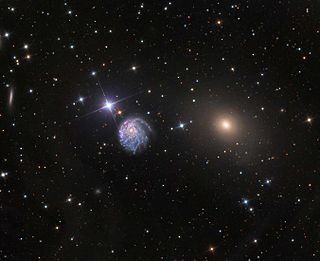
NGC 2276 is an intermediate spiral galaxy in the constellation Cepheus. The galaxy lies 120 million light-years away from Earth. NGC 2276 has an asymmetrical appearance, most likely caused by gravitational interactions with its neighbor, elliptical galaxy NGC 2300. NGC 2276 is traveling with an orbital velocity of about 968 km/s due to its neighbor. Trailing NGC 2276 is a long tail of interstellar medium about 300,000 light-years long, formed by ram pressure stripping.
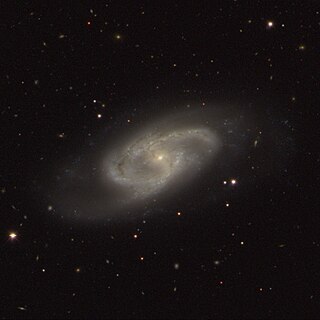
NGC 150 is a barred spiral galaxy in the constellation Sculptor. It is about 63 million light years away from the Solar System, and it has a diameter of about 94,000 light years. It was discovered by Lewis A. Swift on 20 November 1886.
SN 2013fs is a supernova, located in the spiral galaxy NGC 7610, discovered by the Intermediate Palomar Transient Factory sky survey at Palomar Observatory on 6 October 2013. It was discovered approximately three hours from explosion and was observed in ultraviolet and X-ray wavelengths, among others, within several hours. Optical spectra were obtained beginning at six hours from explosion, making these the earliest such detailed observations ever made of a supernova. The supernova was also independently discovered by Kōichi Itagaki on 7 October 2013.

NGC 5837 is a barred spiral galaxy in the constellation Boötes. It was discovered on 19 June 1887 by Lewis A. Swift.

NGC 7038 is an intermediate spiral galaxy located about 210 million light-years away in the constellation of Indus. Astronomer John Herschel discovered NGC 7038 on September 30, 1834.
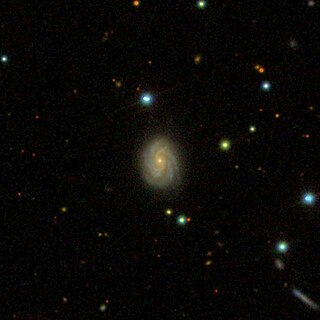
NGC 819 is a spiral galaxy approximately 302 million light-years away from Earth in the constellation of Triangulum. It forms a visual pair with the galaxy NGC 816 5.7' WNW.

NGC 2801 is an unbarred spiral galaxy in the constellation Cancer. Its velocity with respect to the cosmic microwave background is 8011 ± 20 km/s, which corresponds to a Hubble distance of 385.4 ± 27.0 Mly (118.16 ± 8.28 Mpc). It was discovered February 17, 1865, by Albert Marth.

NGC 1285 is a barred spiral galaxy in the constellation of Eridanus. Its velocity with respect to the cosmic microwave background is 5081 ± 12 km/s, which corresponds to a Hubble distance of 244.4 ± 17.1 Mly (74.94 ± 5.25 Mpc). However, three non-redshift measurements give a distance of 180.47 ± 3.24 Mly (55.333 ± 0.994 Mpc). It was discovered by Heinrich Louis d'Arrest on 28 October 1865.
